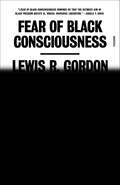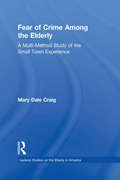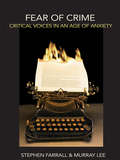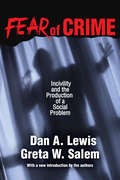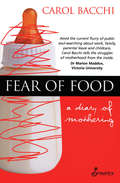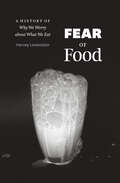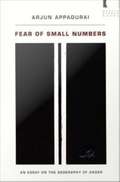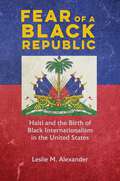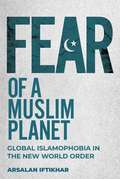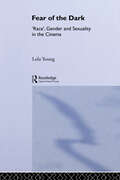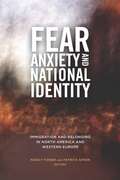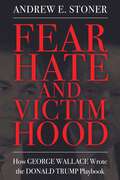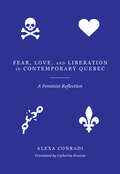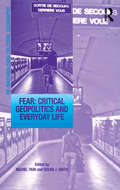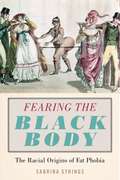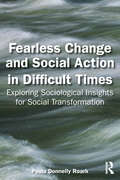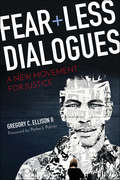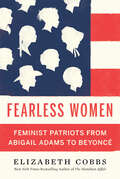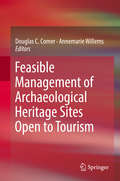- Table View
- List View
Fear of Black Consciousness
by Lewis R. GordonLewis R. Gordon's Fear of Black Consciousness is a groundbreaking account of Black consciousness by a leading philosopherIn this original and penetrating work, Lewis R. Gordon, one of the leading scholars of Black existentialism and anti-Blackness, takes the reader on a journey through the historical development of racialized Blackness, the problems this kind of consciousness produces, and the many creative responses from Black and non-Black communities in contemporary struggles for dignity and freedom. Skillfully navigating a difficult and traumatic terrain, Gordon cuts through the mist of white narcissism and the versions of consciousness it perpetuates. He exposes the bad faith at the heart of many discussions about race and racism not only in America but across the globe, including those who think of themselves as "color blind." As Gordon reveals, these lies offer many white people an inherited sense of being extraordinary, a license to do as they please. But for many if not most Blacks, to live an ordinary life in a white-dominated society is an extraordinary achievement.Informed by Gordon's life growing up in Jamaica and the Bronx, and taking as a touchstone the pandemic and the uprisings against police violence, Fear of Black Consciousness is a groundbreaking work that positions Black consciousness as a political commitment and creative practice, richly layered through art, love, and revolutionary action.
Fear of Crime Among the Elderly: A Multi-Method Study of the Small Town Experience (Garland Studies on the Elderly in America)
by Mary Dale CraigFirst published in 2000. Routledge is an imprint of Taylor & Francis, an informa company.
Fear of Crime: Critical Voices in an Age of Anxiety (The\international Library Of Criminology, Criminal Justice And Penology Ser. #44)
by Stephen Farrall Murray LeeAn attention to the 'fear of crime' has found its way into governmental interventions in crime prevention and into popular discourse with many newspapers, local government and the like conducting their own fear of crime surveys. As a concept, 'fear of crime' has also produced considerable academic debate since it entered the criminological vocabulary in the 1960s. Bringing together a collection of new and cutting edge articles from key scholars in criminology, Fear of Crime challenges many assumptions which remain submerged in attempts to measure and attribute cause to crime fear. But, in questioning the orthodoxy of 'fear of crime' models, along with inquiries that have supposed that fear is objectively quantifiable and measurable, the articles collected here also offer new paradigms and methods of inquiry for approaching 'fear of crime'.
Fear of Crime: Incivility and the Production of a Social Problem
by Dan A. LewisMost studies of fear of crime assume that is rimarily induced by direct or indirect contact with a criminal event. Consequently programs designed to deal with this problem focus on either increased police protection or a number of crime prevention programs. In this study, Dan A. Lewis and Greta W. Salem raise questions both about the validity of these assumptions and the effectiveness of the programs. A five-year investigation has led the authors to challenge those theories that focus only on the psychological responses to victimizations and fail to take into account the social and political environments within which such fears are shaped and nurtured.Explicitly laying out a 'social control' perspective which informs their research and analysis, the authors examine the fear of crime in ten neighorhoods in Chicago, San Francisco, and Philadelphia which represent the range of communities typically found in urban areas. On the basis of their analysis the authors contend that fear of crime is not related to exposure or knowledge about criminal events alone but also stems from residents' concerns about broad changes taking place in their neighborhoods. Many people, they argue, are afraid not only because crime occurs but also because they believe that they have lost control over the environment in which they live.Lewis and Salem conclude that the eradication of fear of crime requires strategies that move beyond the traditional crime prevention programs to consider ways to restore the control that community residents feel they have lost and the possibilities for a more equitable distribution of security in urban areas.
Fear of Falling: The Inner Life of the Middle Class
by Barbara EhrenreichA brilliant and insightful exploration of the rise and fall of the American middle class by New York Times bestselling author, Barbara Ehrenreich. One of Barbara Ehrenreich's most classic and prophetic works, Fear of Falling closely examines the insecurities of the American middle class in an attempt to explain its turn to the right during the last two decades of the 20th century. Weaving finely-tuned expert analysis with her trademark voice, Ehrenreich traces the myths about the middle class to their roots, determines what led to the shrinking of what was once a healthy percentage of the population, and how, in its ambition and anxiety, that population has retreated from responsible leadership.Newly reissued and timely as ever, Fear of Falling places the middle class of yesterday under the microscope and reveals exactly how we arrived at the middle class of today.
Fear of Food: A Diary of Mothering
by Carol BacchiIncorporating diary entries and reflections, this personal account of one mother's struggles during the first 12 months of her son's life to get him to eat openly confronts the social challenges mothers encounter, including insensitive doctors, the marketing of maternity in the media, postpartum depression, and social isolation. The stinging question What if I don't love my child enough? is explored in this highly personal and moving story that argues mothers must speak out about the challenges and traumas they face in order to be understood.
Fear of Food: A History of Why We Worry about What We Eat
by Harvey LevensteinAn &“entertaining and enlightening&” history of the scares, scams, and pseudoscience that have made food a source of anxiety in America (The Boston Globe). Are eggs the perfect protein, or cholesterol bombs? Is red wine good for my heart, or bad for my liver? Will pesticides and processed foods kill me? In this book, food historian Harvey Levenstein encourages us to take a deep breath, and reveals the people and vested interests who have created and exploited so many worries surrounding the subject of what we eat. He tells of the prominent scientists who first warned about deadly germs and poisons, and those who charged that processing foods robs them of life-giving vitamins and minerals. These include Nobel laureate Eli Metchnikoff, who advised that yogurt would enable people to live to 140, and Elmer McCollum, the &“discoverer&” of vitamins, who tailored his warnings about deficiencies to suit the food producers who funded him. He also highlights how companies have taken advantage of these concerns—by marketing their products to the fear of the moment. Fear of Food is a lively look at the food industry and American culture, as well as a much-needed voice of reason; Levenstein expertly questions these stories of constantly changing advice, and helps free us from irrational fears so we can rediscover the joy of eating. &“Guides us through an entertaining series of obsessions—from the outsized fear of flies spreading germs (leading to the 1905 invention of the fly swatter) to a panic about germ-ridden cats infecting human food (which led to a 1912 Chicago public health warning that felines were &‘extremely dangerous to humanity&’)…[a] roster of American food nuttiness.&”—TheBoston Globe &“[Takes] readers through a succession of American fads and panics, from an epidemic of &‘germophobia&’ at the start of the twentieth century to fat phobia at its end. He exposes the instigators of these panics: not only the hucksters and opportunists but also the scientists and health experts.&”—Times Literary Supplement
Fear of Small Numbers: An Essay on the Geography of Anger
by Arjun AppaduraiThe period since 1989 has been marked by the global endorsement of open markets, the free flow of finance capital and liberal ideas of constitutional rule, and the active expansion of human rights. Why, then, in this era of intense globalization, has there been a proliferation of violence, of ethnic cleansing on the one hand and extreme forms of political violence against civilian populations on the other? Fear of Small Numbers is Arjun Appadurai's answer to that question. A leading theorist of globalization, Appadurai turns his attention to the complex dynamics fueling large-scale, culturally motivated violence, from the genocides that racked Eastern Europe, Rwanda, and India in the early 1990s to the contemporary "war on terror. " Providing a conceptually innovative framework for understanding sources of global violence, he describes how the nation-state has grown ambivalent about minorities at the same time that minorities, because of global communication technologies and migration flows, increasingly see themselves as parts of powerful global majorities. By exacerbating the inequalities produced by globalization, the volatile, slippery relationship between majorities and minorities foments the desire to eradicate cultural difference. Appadurai analyzes the darker side of globalization: suicide bombings; anti-Americanism; the surplus of rage manifest in televised beheadings; the clash of global ideologies; and the difficulties that flexible, cellular organizations such as Al-Qaeda present to centralized, "vertebrate" structures such as national governments. Powerful, provocative, and timely, Fear of Small Numbers is a thoughtful invitation to rethink what violence is in an age of globalization.
Fear of a Black Nation: Race, Sex, and Security in Sixties Montreal
by David AustinIn the 1960s, for at least a brief moment, Montreal became what seemed an unlikely centre of Black Power and the Caribbean left. In October 1968 the Congress of Black Writers at McGill University brought together well-known Black thinkers and activists from Canada, the United States, Africa, and the Caribbean—people like C.L.R. James, Stokely Carmichael, Miriam Makeba, Rocky Jones, and Walter Rodney. Within months of the Congress, a Black-led protest at Sir George Williams University (now Concordia) exploded on the front pages of newspapers across the country—raising state security fears about Montreal as the new hotbed of international Black radical politics.
Fear of a Black Nation: Race, Sex, and Security in Sixties Montreal
by David AustinIn the 1960s, Montreal was a hotbed of radical politics that attracted Black and Caribbean figures such as C.L.R. James, Walter Rodney, Mariam Makeba, Stokely Carmichael, Rocky Jones, and Édouard Glissant. It was also a place where the ideas of Frantz Fanon, Aimé Césaire, and Malcolm X circulated alongside those of Karl Marx, Jean-Paul Sartre, and Simone de Beauvoir. During this period of global upheaval and heightened Canadian and Quebec nationalism, Montreal became a central site of Black and Caribbean radical politics. Situating Canada within the Black radical tradition and its Caribbean radical counterpart, Fear of a Black Nation paints a history of Montreal and the Black activists who lived in, sojourned in, or visited the city and agitated for change. Drawing on Saidiya Hartman’s conception of slavery’s afterlife and what David Austin describes as biosexuality – a deeply embedded fear of Black self-organization and interracial solidarity – Fear of a Black Nation argues that the policing and surveillance of Black lives today is tied to the racial, including sexual, codes and practices and the discipline and punishment associated with slavery. As meditation on Black radical politics and state security surveillance and repression, Fear of a Black Nation combines theoretical and philosophical inquiry with literary, oral, and archival sources to reflect on Black political organizing. In reflecting on Black self-organization and historic events such as the Congress of Black Writers and the Sir George Williams Affair, the book ultimately poses the question: what can past freedom struggles teach us about the struggle for freedom today? Featuring two new interviews with the author and a new preface, this expanded second edition enriches the political and theoretical conversation on Black organising and movement building in Canada and internationally. As the Black Lives Matter and abolition movements today popularize calls to disarm and defund the police and to abolish prisons, Fear of a Black Nation provides an invaluable reflection on the policing of Black activism and a compelling political analysis of social movements and freedom struggles that is more relevant now than ever.
Fear of a Black Republic: Haiti and the Birth of Black Internationalism in the United States (Black Internationalism)
by Leslie M. AlexanderThe emergence of Haiti as a sovereign Black nation lit a beacon of hope for Black people throughout the African diaspora. Leslie M. Alexander’s study reveals the untold story of how free and enslaved Black people in the United States defended the young Caribbean nation from forces intent on maintaining slavery and white supremacy. Concentrating on Haiti’s place in the history of Black internationalism, Alexander illuminates the ways Haitian independence influenced Black thought and action in the United States. As she shows, Haiti embodied what whites feared most: Black revolution and Black victory. Thus inspired, Black activists in the United States embraced a common identity with Haiti’s people, forging the idea of a united struggle that merged the destinies of Haiti with their own striving for freedom. A bold exploration of Black internationalism’s origins, Fear of a Black Republic links the Haitian revolution to the global Black pursuit of liberation, justice, and social equality.
Fear of a Muslim Planet: Global Islamophobia in the New World Order
by Arsalan IftikharGlobal Media Commentator Arsalan Iftikhar takes on Islamophobia through the lens of the brutal Christchurch slaughter. In March 2019, a heavily-armed white supremacist walked into two mosques in Christchurch, New Zealand and slaughtered fifty-one innocent Muslim worshippers while broadcasting on Facebook Live for the world to see. After the Christchurch mosque massacre, authorities found the white supremacist&’s seventy-four-page racist manifesto called &“The Great Replacement,&” which railed against Muslims and the idea that brown Muslim folks were ultimately going to &“replace&” white people in his irrational &“Fear of Muslim Planet.&”Fear of a Muslim Planet begins with the treacherous legacy of the white supremacist &“Great Replacement&” theory in the aftermath of the Christchurch massacre. One of the heroes for the Christchurch shooter was the infamous Norwegian anti-Muslim terrorist named Anders Breivik, who brutally murdered seventy-seven people in 2011 in Norway&’s worst terrorist attack ever and whose own 1,500-page fascist manifesto promoted thr &“Great Replacement&” worldview that Muslim immigrants posed a danger to Western societies.As the book further illustrates, minority victims of the &“Great Replacement&” conspiracy theory are not limited to Muslims alone. In October 2018, the Tree of Life synagogue in Pittsburgh was devastated when a white supremacist brutally executed eleven innocent Jewish congregants in a horrific act of anti-Semitic terrorism (it was the single deadliest attack exclusively targeting Jews ever to happen in the United States). The shooter later told police that he was inspired to commit these murders because Donald Trump was not doing enough to stop immigration. &“Open your Eyes!&” the shooter posted on social media in a disjointed anti-Semitic and Islamophobic manifesto. &“It&’s the filthy EVIL jews Bringing the Filthy EVIL Muslims into the Country!!&”The presidency of Donald Trump has only exacerbated the growth of Islamophobia in America today. Fear of a Muslim Planet outlines the blatantly anti-Muslim statements and policies of Trump and his closest political circle. From telling CNN&’s Anderson Cooper that &“I think Islam hates us&” to calling for a &“complete and total shutdown&” of Muslims entering the United States, the Trump presidency has only made the xenophobic specter of Islamophobia grow today.The book will also show that Islamophobia is not simply an American (or Western) problem either. Fear of a Muslim Planet will show the genocidal levels of Islamophobia in places like China and Myanmar. The European fixation on policing Muslim women&’s hijab (headscarf) is another focal point. The book ends with a clarion call for mutual understanding and coexistence among people of all backgrounds, if we have the courage to summon our better selves and look beyond each other&’s race, religion, and ethnic backgrounds.
Fear of the Dark: 'Race', Gender and Sexuality in the Cinema
by Lola YoungStudies of the portrayal of black people in film have tended to be studies for the ideological correctness of the depictions of black people and the extent to which they rely on stereotypes. By closely examining films such as Sapphire (1959), Leo the Last (1969), Black Joy (1977), Playing Away (1986) and Mona Lisa (1987) and situating them in their historical and social context, Fear of the Dark develops a particualar critical perspective on the film portrayal of black female sexuality and questions the extent to which black film makers have challenged stereotypes.
Fear, Anxiety, and National Identity: Immigration and Belonging in North America and Western Europe
by Nancy Foner Patrick SimonFifty years of large-scale immigration has brought significant ethnic, racial, and religious diversity to North America and Western Europe, but has also prompted hostile backlashes. In Fear, Anxiety, and National Identity, a distinguished multidisciplinary group of scholars examine whether and how immigrants and their offspring have been included in the prevailing national identity in the societies where they now live and to what extent they remain perpetual foreigners in the eyes of the long-established native-born. What specific social forces in each country account for the barriers immigrants and their children face, and how do anxieties about immigrant integration and national identity differ on the two sides of the Atlantic? Western European countries such as Germany, the Netherlands, and the United Kingdom have witnessed a significant increase in Muslim immigrants, which has given rise to nativist groups that question their belonging. Contributors Thomas Faist and Christian Ulbricht discuss how German politicians have implicitly compared the purported “backward” values of Muslim immigrants with the German idea of Leitkultur, or a society that values civil liberties and human rights, reinforcing the symbolic exclusion of Muslim immigrants. Similarly, Marieke Slootman and Jan Willem Duyvendak find that in the Netherlands, the conception of citizenship has shifted to focus less on political rights and duties and more on cultural norms and values. In this context, Turkish and Moroccan Muslim immigrants face increasing pressure to adopt “Dutch” culture, yet are simultaneously portrayed as having regressive views on gender and sexuality that make them unable to assimilate. Religion is less of a barrier to immigrants’ inclusion in the United States, where instead undocumented status drives much of the political and social marginalization of immigrants. As Mary C. Waters and Philip Kasinitz note, undocumented immigrants in the United States. are ineligible for the services and freedoms that citizens take for granted and often live in fear of detention and deportation. Yet, as Irene Bloemraad points out, Americans’ conception of national identity expanded to be more inclusive of immigrants and their children with political mobilization and changes in law, institutions, and culture in the wake of the Civil Rights Movement. Canadians’ views also dramatically expanded in recent decades, with multiculturalism now an important part of their national identity, in contrast to Europeans’ fear that diversity undermines national solidarity. With immigration to North America and Western Europe a continuing reality, each region will have to confront anti-immigrant sentiments that create barriers for and threaten the inclusion of newcomers. Fear, Anxiety, and National Identity investigates the multifaceted connections among immigration, belonging, and citizenship, and provides new ways of thinking about national identity.
Fear, Hate, and Victimhood: How George Wallace Wrote the Donald Trump Playbook (Race, Rhetoric, and Media Series)
by Andrew E. StonerWhen Donald Trump announced his campaign for president in 2015, journalists, historians, and politicians alike attempted to compare his candidacy to that of Governor George Wallace. Like Trump, Wallace, who launched four presidential campaigns between 1964 and 1976, utilized rhetoric based in resentment, nationalism, and anger to sway and eventually captivate voters among America’s white majority. Though separated by almost half a century, the campaigns of both Wallace and Trump broke new grounds for political partisanship and divisiveness.In Fear, Hate, and Victimhood: How George Wallace Wrote the Donald Trump Playbook, author Andrew E. Stoner conducts a deep analysis of the two candidates, their campaigns, and their speeches and activities, as well as their coverage by the media, through the lens of demagogic rhetoric. Though past work on Wallace argues conventional politics overcame the candidate, Stoner makes the case that Wallace may in fact be a prelude to the more successful Trump campaign.Stoner considers how ideas about “in-group” and “out-group” mentalities operate in politics, how anti-establishment views permeate much of the rhetoric in question, and how expressions of victimhood often paradoxically characterize the language of a leader praised for “telling it like it is.” He also examines the role of political spectacle in each candidate’s campaigns, exploring how media struggles to respond to—let alone document—demagogic rhetoric.Ultimately, the author suggests that the Trump presidency can be understood as an actualized version of the Wallace presidency that never was. Though vast differences exist, the demagogic positioning of both men provides a framework to dissect these times—and perhaps a valuable warning about what is possible in our highly digitized information society.
Fear, Love, and Liberation in Contemporary Québec: A Feminist Reflection
by Alexa ConradiIn response to rapid and unsettling social, economic, and climate changes, fearmongering now features as a main component of public life. Right-wing nationalist populism has become a hallmark of politics around the world. No less so in Quebec. Alexa Conradi has made it her life’s work to understand and to generate thoughtful debate about this worrisome trend. As the first President of Québec solidaire and the president of Canada’s largest feminist organisation, the Fédération des femmes du Québec, Conradi refused to shy away from difficult issues: the Charter of Quebec Values, religion and Islam, sovereignty, rape culture and violence against women, extractive industries and the treatment of Indigenous women, austerity policy and the growing gap between rich and poor. This determination to address uncomfortable subjects has made Conradi—an anglo-Montrealer—a sometimes controversial leader. In Fear, Love, and Liberation in Contemporary Quebec, Conradi invites us to take off our rose-coloured glasses and to examine Quebec’s treatment of women with more honesty. Through her personal reflections on Quebec politics and culture, she dispels the myth that gender equality has been achieved and paves the way for a more critical understanding of what remains to be done.
Fear, Society, and the Police
by Dale L. JuneFear, Society, and the Police examines elements of fear and how they can be controlled and turned into an effective and proper response in an emergency situation. Readers of this book will be exposed to ways fear can become an uncontrolled emotion, often leading to unnecessary acts of violence, and will examine ways and means of using reasoning to overcome unfounded fear. The author encourages readers to critically assess circumstances in today’s society that have caused fear, unrest, and division between the enforcers of law and the people they are sworn to protect. Providing examples of how violence in society has had an impact on police–community relations, this book examines the many facets of fear from several perspectives, including historical, personal, and institutional. Security management courses concentrate on the "how and why" of security, yet to become an effective professional security specialist it is recommended the practitioner become educated in the nuances of fear. This book presents a look into the how and why of fear, and will relate to security personnel as it does to police officers. The book brings perspectives based on reality and experience. It will be of interest not only to those who work in law enforcement, but also to students in criminal justice, management and leadership, psychology, and sociology courses. As violence in society escalates, professionalism will require more understanding of fear-based emotions.
Fear: Critical Geopolitics And Everyday Life
by Susan J. Smith'Fear' in the twenty-first century has greater currency in western societies than ever before. Through scares ranging from cot death, juvenile crime, internet porn, asylum seekers, dirty bombs and avian flu, we are bombarded with messages about emerging risks. This book takes stock of a range of issues of 'fear' and presents new theoretical arguments and research findings that cover topics as diverse as the war on terror, the immigration crisis, stranger danger, global disease epidemics and sectarian violence. This book charts the association of fear discourses with particular spaces, times, social identities and sets of geopolitical relations. It examines the ways in which fear may be manufactured and manipulated for political purposes, sometimes becoming a tool of repression, and relates fear to political, economic and social marginalization at different scales. Furthermore, it highlights the importance and sometimes unpredictability of everyday lived experiences of fear - the many ways in which people recognize, make sense of and manage fear; the extent of resistance to fear; the relation of fear and hope in everyday life; and the role of emotions in galvanizing political and social action and change.
Fearing the Black Body: The Racial Origins of Fat Phobia
by Sabrina StringsWinner, 2020 Body and Embodiment Best Publication Award, given by the American Sociological AssociationHonorable Mention, 2020 Sociology of Sex and Gender Distinguished Book Award, given by the American Sociological AssociationHow the female body has been racialized for over two hundred years There is an obesity epidemic in this country and poor black women are particularly stigmatized as “diseased” and a burden on the public health care system. This is only the most recent incarnation of the fear of fat black women, which Sabrina Strings shows took root more than two hundred years ago.Strings weaves together an eye-opening historical narrative ranging from the Renaissance to the current moment, analyzing important works of art, newspaper and magazine articles, and scientific literature and medical journals—where fat bodies were once praised—showing that fat phobia, as it relates to black women, did not originate with medical findings, but with the Enlightenment era belief that fatness was evidence of “savagery” and racial inferiority. The author argues that the contemporary ideal of slenderness is, at its very core, racialized and racist. Indeed, it was not until the early twentieth century, when racialized attitudes against fatness were already entrenched in the culture, that the medical establishment began its crusade against obesity. An important and original work, Fearing the Black Body argues convincingly that fat phobia isn’t about health at all, but rather a means of using the body to validate race, class, and gender prejudice.
Fearing the Immigrant: Racialization and Urban Policy in Toronto
by Parastou SaberiA fascinating deep dive into one city&’s urban policy—and the anxiety over immigrants that informs it The city of Toronto is often held up as a leader in diversity and inclusion. In Fearing the Immigrant, however, Parastou Saberi argues that Toronto&’s urban policies are influenced by a territorialized and racialized security agenda—one that parallels the &“War on Terror.&” Focusing on the figure of the immigrant and so-called immigrant neighborhoods as the targets of urban policy, Saberi offers an innovative, multidisciplinary approach to the politics of racialization and the governing of alterity through space in contemporary cities.A comprehensive study of urban policymaking in Canada&’s largest city from the 1990s to the late 2010s, Fearing the Immigrant uses Toronto as a jumping-off point to understand how the nexus of development, racialization, and security works at the urban and international levels. Saberi situates urban policymaking in Toronto in relation to the dominant policies of international development and public health, counterinsurgency, and humanitarian intervention. Engaging with the genealogies and contemporary developments of major policy techniques involving mapping and policy concepts such as poverty, security, policing, development, empowerment, as well as social determinants of health, equity, and prevention, she scrutinizes the parallel ways these techniques and concepts operate in urban policy and international relations. Fearing the Immigrant ultimately asserts that the geopolitical fear of the immigrant is central to the formation of urban policy in Toronto. Rather than addressing the root causes of poverty, urban policy as it has been practiced aims to pacify the specter of urban unrest and to secure the production of a neocolonial urban order. As such, this book is an urgent call to reimagine urban policy in the name of equality and social justice.
Fearless Change and Social Action in Difficult Times: Exploring Sociological Insights for Social Transformation
by Paula Donnelly RoarkOur divided politics, unable to solve the challenges we face concerning society’s hierarchies of injustice, poverty, endless war, and climate change, are now backtracking to even more division. But the reality goes far deeper than the simple politics of left and right. For true change, we need something more profound: a culture shift, a collective change of consciousness.Fearless Change and Social Action in Difficult Times argues that culture shifts don’t just happen, they require a strong focus on social and cultural human connection which neither political nor economic power can provide alone. It is only deep participation and social integrative power which have the capacity to create these necessary cultural and societal transformations. Developing awareness in participatory groups of thought-worlds which remain out-of-sight but give cover to the implicit rules of culture and society is the first step to creating shared awareness of constructs and negative thought-worlds that subconsciously support inequality. Consciously putting aside those that are negative allows for the emergence of new positive realities and social movements. Thus, the real revolution is of the mind. It does take courage, but this is the process by which better futures are created.Offering significant contributions to sociology and social theory, this book promotes an understanding that societal change is rooted in social power and cultural shifts. Inclusive in its presentation, students, professors, NGO professionals, volunteers, activists, and interested observers will find this book of high interest.
Fearless Dialogues: A New Movement For Justice
by Gregory C. Ellison IIDrawing on all the community's collective voices--from "doctors to drug dealers"--Fearless Dialogues is a groundbreaking program that seeks real solutions to problems of chronic unemployment, violence, and hopelessness. In cities around the United States and now the world, the program's founder, Gregory C. Ellison, and his team create conversations among community members who have never spoken to one another, the goal of which are real, implementable, and lasting changes to the life of the community. <P><P>These community transformations are based on both face-to-face encounters and substantive analysis of the problems the community faces. In Fearless Dialogues: A New Movement for Justice, Ellison makes this same kind of analysis available to readers, walking them through the steps that must be taken to find common ground in our divided communities and then to implement genuine and lasting change.
Fearless Women: Feminist Patriots from Abigail Adams to Beyoncé
by Elizabeth CobbsThis passionate and inspiring book by the New York Times bestselling author of The Hello Girls shows us that the quest for women’s rights is deeply entwined with the founding story of the United States.When America became a nation, a woman had no legal existence beyond her husband. If he abused her, she couldn’t leave without abandoning her children. Abigail Adams tried to change this, reminding her husband John to “remember the ladies” when he wrote the Constitution. He simply laughed—and women have been fighting for their rights ever since.Fearless Women tells the story of women who dared to take destiny into their own hands. They were feminists and antifeminists, activists and homemakers, victims of abuse and pathbreaking professionals. Inspired by the nation’s ideals and fueled by an unshakeable sense of right and wrong, they wouldn’t take no for an answer. In time, they carried the country with them.The first right they won was the right to learn. Later, impassioned teachers like Angelina Grimké and Susan B. Anthony campaigned for the right to speak in public, lobby the government, and own property. Some were passionate abolitionists. Others fought just to protect their own children.Many of these women devoted their lives to the cause—some are famous—but most pressed their demands far from the spotlight, insisting on their right to vote, sit on a jury, control the timing of their pregnancies, enjoy equal partnerships, or earn a living. At every step, they faced fierce opposition. Elizabeth Cobbs gives voice to fearless women on both sides of the aisle, most of whom considered themselves patriots. Rich and poor, from all backgrounds and regions, they show that the women’s movement has never been an exclusive club.
Fearon's Our Century 1950-1960
by S. D. JonesThis “magazine” style history series reinforces the reality of history and makes reading about it more engaging to the student. Topics include daily life, around the world, back at home, sports world, arts, people in the news, and more. Reading Level: 3-4 Interest Level: 6-12
Feasible Management of Archaeological Heritage Sites Open to Tourism
by Douglas C. Comer Annemarie WillemsArchaeological sites opened to the public, and especially those highly photogenic sites that have achieved iconic status, are often major tourist attractions. By opening an archaeological site to tourism, threats and opportunities will emerge.The threats are to the archaeological record, the pre-historic or historic materials in context at the site that can provide facts about human history and the human relationship to the environment. The opportunities are to share what can be learned at archaeological sites and how it can be learned. The latter is important because doing so can build a public constituency for archaeology that appreciates and will support the potential of archaeology to contribute to conversations about contemporary issues, such as the root causes and possible solutions to conflict among humans and the social implications of environmental degradation. In this volume we will consider factors that render effective management of archaeological sites open to the public feasible, and therefore sustainable. We approach this in two ways: The first is by presenting some promising ways to assess and enhance the feasibility of establishing effective management. Assessing feasibility involves examining tourism potential, which must consider the demographic sectors from which visitors to the site are drawn or might be in the future, identifying preservation issues associated with hosting visitors from the various demographic sectors, and the possibility and means by which local communities might be engaged in identifying issues and generating long-term support for effective management. The second part of the book will provide brief case studies of places and ways in which the feasibility of sustainable management has been improved.
